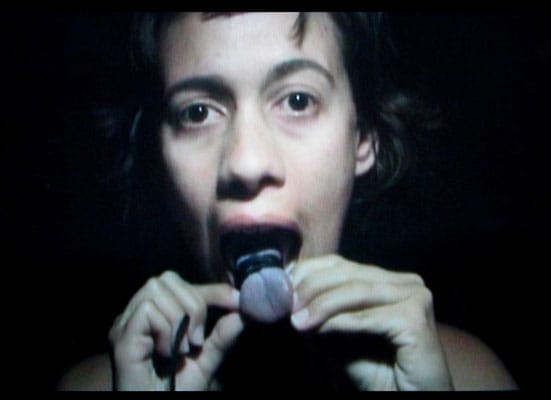23rd January 2008 — 22nd March 2008
Since I visited 'States of Exchange' a month ago, Fidel Castro has stepped down as Cuba's leader after 49 years in power and his brother Raul has taken over. As Raul is nearly as old as Fidel the world is waiting with baited breath to see what will happen next in Cuba's increasingly fragile-looking regime. What ideology will the younger generation espouse? Will they maintain the purity of the revolution or adopt the Chinese model? What will happen when a new American president assumes power, will there be an olive branch? The timing of Iniva's exhibition is very apt, as the world scrutinises the living anachronism that is Cuba. 'States of Exchange' also encourages us to reflect that we are all implicated in the fiction we call Cuba.
This exhibition, curated by Cylena Simonds and Gerardo Mosquera, showcases the work of six young Cuban artists unfamiliar to a British audience. It examines the varying types of economic and information exchange prevalent in Cuba today. The publicity states: 'At a time when borderless communication is assumed to be the global norm, Cuba is a country caught in flux. With two legal currencies, minimal internet access, and divisions between those who can and can't access external resources, the residents of Cuba have become experts at negotiating the complexities of exchange between each other and the world.' Mosquera elaborates that his show: 'aims to show how artists in Cuba discuss contradictions, ambiguities and social negotiations in Cuban life'. Less than 2% of Cuba's residents have access to the internet, which is prohibitively expensive there. When we consider our daily reliance on the web for both work and pleasure, this is a shocking statistic.
The exhibition is tightly curated and offers a unified aesthetic. The works are simple, humorous and oblique. Visually they recall conceptual art and body performance art from the 60s and 70s, and Arte Povera.
My favourite works in the show were by Jeanette Chavez and Diana Fonesca. In the foyer Chavez's military epaulettes make a sky of yellow and black stars. In her powerful video work 'Self-censorship', Chavez, in close-up, ties string around her tongue until it turns blue then horrifyingly black. She then closes her mouth to hide her silence. The black tongue speaks of death. Chavez's action directly addresses the prohibition of freedom of speech. Whether living under a Communist regime, or a supposedly Democratic surveillance society, citizens are often like prisoners in a Panopticon gaol, not daring to speak in case they are being observed. One way or another, they are indoctrinated to self-censure, like the characters in Orwell's '1984'. Different in intention to protestors who draw attention to their plight by sewing up their mouths or going on hunger strike, Chavez's work communicates an internalized anguish. It is not a public spectacle but suggests interior damage and isolation.
In her video 'Past time' Fonesca sews a succession of simple images like children's drawings onto the surface of her palm. A boat, an aeroplane, a house; they seem to speak of a yearning for escape or security. The work is beautiful to watch and yet sickening as the familiar act of sewing unfolds on human skin. In 'Pastime (money)', to the soundtrack of a cash register ringing, two coins move in jerky circles on Fonesca's palms, gradually leaving round dirty marks imprinted on her hands. Her hands-out-with-open-palm position evokes begging, or buying and selling. The work addresses the way capital is increased by being shuttled around markets and asks: is money inherently dirty?
In his work, Wilfriedo Prieto plays with scale. In 'Untitled (pea)' he paints a tiny pea into a globe, perhaps as a comment on the false utopia of globalisation? In 'One million dollars' a single dollar bill is reflected to infinity. Is Prieto commenting on the unreality of the global economy and the strategies of capitalism? His unambiguous, mischievous installation 'Speech' consists of a tiled wall with two loo roll holders containing newspapers pages from Cuba's official paper 'Granma'.
Commentary on Cuba's unique economic situation abounds. Yoan Capote's 'Bilingual Money' is a useless hybrid of a US quarter and a Cuban 20 cent coin. Meanwhile in 'Perpetual Mobile' his brother Ivan Capote documents a performance in which he filed down a coin. He mixed the resulting metal dust with the sweat produced by the action of filing and presents the results in a test-tube. I am reminded of the line in Genesis when man is cursed: 'In the sweat of thy face shalt thou eat bread, till thou return unto the ground'.
Lazaro Saavedra shows video works with elliptical symbolic narratives in which red beans represent citizens. In 'Glory erases memory' a bean separated from the crowd is smashed with a hammer, making the audience jump. In 'Not knowing is like not seeing' all the beans except those at the top of a ziggurat are washed away. I read these works as discussing the betrayal of the revolution or the eternal maxim that all power corrupts. The publicity explains that they explore the dramatic tension between the official representation and the actual experience of Cuba.
If the show leaves you wanting more, check out www.iniva.org for details of an excellent two part video screening programme featuring Cuban artists' shorts and experimental documentaries. As well as exhibition spaces, Iniva's slick new building houses a café and an education space, where I was very pleased to come across Harold Offeh running his Happiness Lab Project.
AM
Iniva - Institute of International Visual Arts
London EC2A 3B
http://www.iniva.org/
Open
Tuesday, Wednesday & Friday, 11am-6pm
Thursday, 11am-9pm
Saturday, 12-6pm

Janette Chavez
Autocensura (Self-censorship) 2006
Still from video
Courtesy of the artist